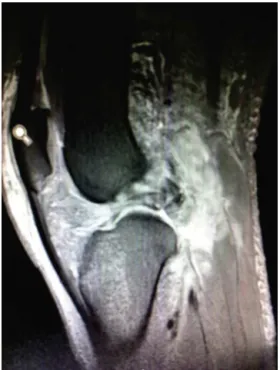rev bras ortop.2015;50(3):348–351
w w w . r b o . o r g . b r
Case
Report
Popliteal
artery
injury
during
posterior
cruciate
ligament
reconstruction
夽
Marcos
Henrique
Frauendorf
Cenni
∗,
Bruno
Fajardo
do
Nascimento,
Guilherme
Galvão
Barreto
Carneiro,
Rodrigo
Cristiano
de
Andrade,
Lúcio
Flávio
Biondi
Pinheiro
Júnior,
Oscar
Pinheiro
Nicolai
HospitalMaterDei,BeloHorizonte,MG,Brazil
a
r
t
i
c
l
e
i
n
f
o
Articlehistory: Received7June2014 Accepted13June2014 Availableonline23April2015
Keywords: Poplitealartery
Posteriorcruciateligament Intraoperativecomplications
a
b
s
t
r
a
c
t
Thisstudyreportsacaseofpoplitealarteryinjuryduringarthroscopicreconstructionof theposteriorcruciateligament.Theevolutionoftheinjuryisdescribedandcommentsare maderegardingtheanatomyofthisarteryandpotentialrisksofthissurgicaltechnique.This studyhadtheaimsofalertingthemedicalcommunity,especiallykneesurgeons,regarding aseveresurgicalcomplicationanddiscussingthewaysofpreventingit.
©2014SociedadeBrasileiradeOrtopediaeTraumatologia.PublishedbyElsevierEditora Ltda.Allrightsreserved.
Lesão
da
artéria
poplítea
durante
a
reconstruc¸ão
do
ligamento
cruzado
posterior
Palavras-chave: Artériapoplítea
Ligamentocruzadoposterior Complicac¸õesintraoperatórias
r
e
s
u
m
o
Este trabalho relata uma lesão da artéria poplítea (AP) durante uma reconstruc¸ão artroscópicadoligamentocruzadoposterior,descrevesua evoluc¸ãoefazconsiderac¸ões sobreaanatomiadessaartériaeosriscospotenciaisdessatécnicacirúrgica.Temcomo objetivoalertara comunidademédica, emespecial os cirurgiões dejoelho, sobreuma complicac¸ãocirúrgicagraveediscutirasformasdepreveni-la.
©2014SociedadeBrasileiradeOrtopediaeTraumatologia.PublicadoporElsevierEditora Ltda.Todososdireitosreservados.
夽
WorkdevelopedintheKneeGroupofHospitalMaterDei,BeloHorizonte,MG,Brazil. ∗ Correspondingauthor.
E-mail:cenni14@gmail.com(M.H.F.Cenni).
http://dx.doi.org/10.1016/j.rboe.2015.04.005
rev bras ortop.2015;50(3):348–351
349
Introduction
Reconstruction surgery on the posterior cruciate ligament (PCL) is a procedure that is well known among knee sur-geons for its complexity, technical difficulty and potential risksofinjuringthevascular-nervousbundleofthepopliteal fossa. The reconstruction techniques can be arthroscopic, openormixed(ofinlaytype).Arthroscopicreconstructionis lessaggressivetowardthepatient,butpresentsgreater tech-nicaldifficultiesandrisks.1
Case
report
OnNovember19,2010,thepatientR.J.M.sufferedacar acci-dent,withseveremultipletrauma,whichledhimtobekept intheintensivecarecenterforfourdays.Hismostsignificant injurieswereamulti-fragmentfractureoftheleftfemoral dia-physis,dislocationoftherightkneeoftypeKDIIIL(tearingof theanteriorandposteriorcruciateligamentsinassociation withinjurytotheposterolateralcorner),tearingofthespleen andavarietyofabrasions(Figs.1and2).
On November 24, 2010, he underwent intramedullary osteosynthesiswitharetrogradenailintroducedintotheleft femur.OnDecember1,2010,heunderwentacuteperipheral repairoftheposterolateralinjurytotherightknee(Fig.3).
HewasreleasedfromhospitalonDecember5,2010,ina goodconditionbutwithanindicationforPCLreconstruction, tobeperformed asasecond operationafterthe peripheral injurieshadhealed.
OnMarch2,2011,heunderwentPCLreconstruction arthro-scopically,inwhichaquadruplegraft fromthegracilisand semitendinosusflexortendonswasused.Attheendofthe operation,it was notedthat the popliteal artery had been injured,giventheeffusivebleedingthroughthe posterome-dialportalandtheabsenceofpulseand distalperfusionin theoperatedlimb.
Thevascularsurgeonwascalledin,onanemergencybasis. Hegot the callpromptly and arrivedinthe operating the-aterafteraround50min.Noadditionaldiagnostictestswere requested, given the high degree of suspicion of vascular injuryandtheneedforemergencyintervention.
Fig.1–Appearanceofthelimbwithposteriorfallofthe tibia.
Fig.2–Magneticresonanceimagingoftheinitiallesion, showingthesevereligamentinjury.
Thepatientwaspositionedinventraldecubitusand under-went revascularizationsurgerywithinterpositionofagraft fromthegreatsaphenousvein,bymeansofTrickey’sposterior access.Therevascularizationwasterminatedfivehoursand 45minafterinflationofthetourniquetfortheligament recon-structionsurgery(i.e.thiswasthetotaldurationofischemiain thelimb)andthepatientwassenttotheintensivecarecenter forpostoperativerecovery.Afterafewhours,thepatientwas returnedtothesurgicalcenterduetopoorperfusionofthe rightleg.AFoghartcatheterwasintroducedandthepatient underwent decompressive fasciotomyofthe four compart-mentsofthesameleg.Thepatientwaskeptintheintensive carecenterforanotherthreedaysandwasreleasedfrom hos-pitalinagoodconditionafter24days.
Aftersixmonthsofrehabilitation,thepatient’scondition presented excellent evolution, with satisfactory functional
350
rev bras ortop.2015;50(3):348–351recoveryandwithoutanyclinicalsignsofposteriorinstability orpoordistalperfusionofthelimbaffected.
Discussion
Complicationsrelatingtoarthroscopicsurgeryarerare. Mul-ticenterstudiesconductedinthe1980sobservedincidences ranging from 0.56% to 1.68%.In 1985, DeLee,2 leading the complicationscommitteeoftheArthroscopyAssociationof North America (AANA), coordinated a national survey on 118,590arthroscopicproceduresperformedonseveraljoints andobservedthat930casesofcomplicationsoccurred(0.8%). Amongthesecases,onlyninewerevascularcomplications,all intheknee,andsixofthemresultedinamputation. Subse-quently,Small3conductedfurtherstudiesthroughthesame committeeoftheAANAandobservedcomplicationratesfrom 0.56%to1.68%.
Thus,vascularcomplicationsareveryrare,butpotentially serious.Outofallkneesurgicalprocedures,PCL reconstruc-tionandtotalarthroplastyaretheonesthatpresentgreatest risk,becauseoftheproximityofthesurgicalinstrumentsto thepoplitealvessels.1,4Severalstudieshavedrawnattention tothestagesofsurgicalproceduresthatpresentrisksof vas-cularinjury,suchasconstructionoftheposteromedialportal, debridement ofthe posteriorcapsule, passageofthe tibial tunnelguideandtunneldrilling.
Usingmagneticresonanceimaging,Kieser4demonstrated thatin93.4%ofthepatientsevaluated,thepoplitealarterywas locatedlaterallytothemidlineoftheknee.Intheremaining patients,itwaslocatedinthecentralareaandnever medi-allytothisline.Thedistancefromthearterytotheposterior edgeofthetibiarangedfrom2.6mmto9.9mm.These find-ingsconfirmthatthereisapotentialriskofinjurythrough passageofthetibialguidewire,whichisorientedslightly lat-erally.
In2004,Barlettetal.,5attheUniversityofMelbourne, Aus-tralia,conductedastudyoninjuriesofthepoplitealvessels and evaluated their incidence, anatomical factors and the influenceofsurgeryandprevioustraumaontheriskofsuch injuriesduringproceduresontheknee.Theydemonstrated thatinaroundonethirdofnormalknees(23/60),thepopliteal arterycameclosetothetibiaasthekneewasflexed.Inknees withPCLinjuries,thisoccurred inalmost79%(11/14).They alsoemphasizedthatpreviousinjuriesorsurgicalprocedures affectingtheposteriorcapsuleofthekneecouldincreasethe riskofinadvertentinjurytothepoplitealvessels,whichmight be adhering to the posterolateral scar tissue. After careful analysisofthecasereportedhere,itwasconcludedthatthe lacerationofthepoplitealarteryoccurredexactlyatthetime ofdebridementoftheposteriorrecessusingashaver,which hadbeendoneinanattempttoobtainagoodviewofthepoint atwhichthetibialtunnelemerged.
Matavaetal.6usedfreshcadaverstostudytheanatomical relationshipbetweenthepoplitealarterialandconstructionof thetibialtunnel.Theydemonstratedthatthetibialguidewire gaverisetoariskofperforationinallthetenmodelsobserved, atflexionsof0◦,45◦and90◦.Onlyatflexionofgreaterthan100◦
didthisriskdiminishpartiallyforsixoftheten.
In2003,Wuetal.7reportedacaseofacutepoplitealartery occlusionduringPCLreconstruction,withspontaneous reso-lutionin12h.
In2005,Makinoetal.8describedanoccurrenceof lacera-tionofthepoplitealarterythatrequiredvascularrepair.The casepresentedgoodevolution.
Nemanietal.9reportedacaseoflacerationofthepopliteal vein and highlighted some suggestionsfor avoiding occur-rencesofthisnature,suchas:keepingtheArthropumpata lowerpressure,toavoidproximitywiththepoplitealvessels; useofdevicestoblockthetibialguidewire,soastoavoid sit-uations inwhichitmight gobeyondthe limitsofthe tibia posteriorly;anduseofradioscopyduringthepassageofthe guideanddrillingofthetibialtunnel.
Theprognosisforpoplitealarteryinjuriesdependsdirectly onthedurationofischemiaandthemagnitudeofthe soft-tissueinjury.Whenpatientsarerevascularizedoveraperiodof lessthansixhoursandnosignificantmusculoskeletaltrauma occurs,theriskofamputationbecomesminimal,asobserved by Khan et al.10 in 2011. Since our patient was promptly attended to bythe vascular surgeon, the total duration of ischemiaoffivehoursand45minwasafundamentalfactor inthegoodevolutionofthecondition.
Although rare, popliteal artery injuries may place the patient’s lower limb, and even hislife, at risk. Intraopera-tivecare needstoberigorouslyobserved, withsafe useof instruments,withradioscopicassistanceandalwayswiththe presenceofavascularsurgeonpreparedtoperform immedi-atevascularrepairorgrafting.Ifvascularinjuryoccurs,the intervention needs to beimmediate, so as toimprove the patient’sprognosis.
Conflicts
of
interest
Theauthorsdeclarenoconflictsofinterest.
r
e
f
e
r
e
n
c
e
s
1.FurieE,YerysP,CutcliffeD,FebreE.Riskfactorsfor arthroscopicpoplitealarterylaceration.Arthroscopy. 1995;11(3):324–7.
2.DeLeeJC,CommitteeonComplicationsoftheArthroscopy AssociationofNorthAmerica.Complicationsofarthroscopy andarthroscopicsurgery:resultsofanationalsurvey. Arthroscopy.1985;1(4):214–20.
3.SmallNC,CommitteeonComplicationsoftheArthroscopy AssociationofNorthAmerica.Complicationsinarthroscopy: thekneeandotherjoints.Arthroscopy.1986;2(4):253–8.
4.KieserC.Areviewofthecomplicationsofarthroscopicknee surgery.Arthroscopy.1992;8(1):79–83.
5.BarlettRJ,RobertsA,WongJ.Risktopoplitealvesselsinmajor kneesurgery,ananatomicalstudyandsurveyofvascular surgeons.JBoneJointSurgBr.2004;86(Suppl4):468.
6.MatavaMJ,SethiNS,TottyWG.Proximityoftheposterior cruciateligamentinsertiontothepoplitealarteryasa functionofthekneeflexionangle:implicationsforposterior cruciateligamentreconstruction.Arthroscopy.
2000;16(8):796–804.
rev bras ortop.2015;50(3):348–351
351
8. MakinoA,Costa-PazM,Aponte-TinaoL,AyerzaMA,Muscolo DL.Poplitealarterylacerationduringarthroscopicposterior cruciateligamentreconstruction.Arthroscopy.
2005;21(11):1396.
9. NemaniVM,FrankRM,ReinhardtKR,Pascual-GarridoC, YankeAB,DrakosM,etal.Poplitealvenotomyduring
posteriorcruciateligamentreconstructioninthesettingofa poplitealarterybypassgraft.Arthroscopy.2012;28(2): 294–9.
